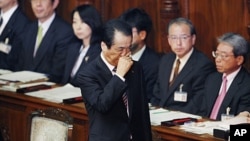Japan’s prime minister has survived a no-confidence motion in parliament. But, Naoto Kan is offering to step down, eventually, once he feels plans to recover from history’s costliest natural disaster are on track.
The Japanese prime minister Thursday, partly under pressure from rebels in his own party, offered to resign once post-disaster reconstruction efforts are in place.
Kan told members of his Democratic Party that he desires to hand over power to a younger generation.
Japan's unprecedented disaster - a major earthquake and tsunami - has left at least 20,000 people dead or missing. It also triggered meltdowns of several reactors at a nuclear power plant on the country’s northeast coast, which spewed
radiation into the atmosphere and sea.
Hours after Kan made his resignation offer, Japan’s parliament rejected a no-confidence motion against his government.
The announcement of the tally of votes in the lower house shows 293 lawmakers voting against the motion, while 152 cast ballots in favor of ousting Kan.
Some of those opposing the prime minister were members of his own party.
Opposition politicians submitted the motion, saying the prime minister has failed to adequately lead Japan during this time of crisis.
Kan’s public approval rating is below 30 percent.
Political analysts suggest the prime minister may be able to stay in office for several more months. He is Japan’s fifth prime minister in five years.
Japan's Prime Minister Survives Ouster Bid









